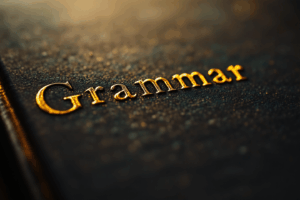
Present Simple Tense 1
English Blogs “Let’s Learn, Explore, and Connect to the World” Present Simple Tense 1 I. Introduction to the Present Simple Tense in English Mastering the


 In the vast landscape of English writing, where every punctuation mark and every word choice matters, there lies a tiny symbol that often determines the clarity of a sentence: the apostrophe. This seemingly insignificant mark carries the weight of meaning on its slender shoulders, distinguishing possession from contraction, days of the week from decades of history. Yet, amidst its various uses, the apostrophe presents a peculiar challenge perplexing writers for generations: the distinction between “its” and “it’s.” This dilemma, often called the “Apostrophe Catastrophe,” is not just a common stumbling block for English learners but also native speakers and seasoned writers alike.
In the vast landscape of English writing, where every punctuation mark and every word choice matters, there lies a tiny symbol that often determines the clarity of a sentence: the apostrophe. This seemingly insignificant mark carries the weight of meaning on its slender shoulders, distinguishing possession from contraction, days of the week from decades of history. Yet, amidst its various uses, the apostrophe presents a peculiar challenge perplexing writers for generations: the distinction between “its” and “it’s.” This dilemma, often called the “Apostrophe Catastrophe,” is not just a common stumbling block for English learners but also native speakers and seasoned writers alike.
 The confusion between “its” and “it’s” might seem trivial to the untrained eye. Still, it’s a litmus test for precision in language that can significantly impact the readability and professionalism of a text. “Its,” the possessive form of “it,” and “it’s,” a contraction for “it is” or “it has,” occupy very different roles in the fabric of English grammar. Yet, they are frequently misused, leading to misunderstandings or the dilution of the intended message.
The confusion between “its” and “it’s” might seem trivial to the untrained eye. Still, it’s a litmus test for precision in language that can significantly impact the readability and professionalism of a text. “Its,” the possessive form of “it,” and “it’s,” a contraction for “it is” or “it has,” occupy very different roles in the fabric of English grammar. Yet, they are frequently misused, leading to misunderstandings or the dilution of the intended message.
 In this guide, we embark on a journey to untangle the “Apostrophe Catastrophe,” offering a beacon of clarity for those navigating the nuanced waters of English punctuation. By dissecting the roles, rules, and applications of “its” and “it’s,” this blog aims to illuminate the correct usage of these terms and reinforce the importance of attention to detail in written communication. Through examples, explanations, and tips, we will master the distinction between “its” and “it’s,” transforming this common source of error into a testament to our linguistic precision and prowess.
In this guide, we embark on a journey to untangle the “Apostrophe Catastrophe,” offering a beacon of clarity for those navigating the nuanced waters of English punctuation. By dissecting the roles, rules, and applications of “its” and “it’s,” this blog aims to illuminate the correct usage of these terms and reinforce the importance of attention to detail in written communication. Through examples, explanations, and tips, we will master the distinction between “its” and “it’s,” transforming this common source of error into a testament to our linguistic precision and prowess.
Join us as we delve into the apostrophe’s history, purpose, and proper application, starting with a foundational understanding before tackling the specifics of “its” vs. “it’s.” Whether you’re a student, a professional, or simply someone passionate about the English language, mastering this aspect of grammar will enhance your writing, ensuring that your messages are conveyed with clarity and accuracy. Let’s demystify the “Apostrophe Catastrophe” together, turning what once was a source of confusion into a showcase of your grammatical expertise.
When denoting possession, the apostrophe helps differentiate between what belongs to whom, a crucial function in English syntax. Adding an apostrophe followed by an “s” (e.g., the dog’s leash) signifies ownership for singular nouns. For plural nouns ending in “s,” the apostrophe is placed after the existing “s” (e.g., the dogs’ leashes), indicating that the item belongs to more than one subject. This rule underscores the apostrophe’s role in clarifying relationships between subjects and objects, a fundamental aspect of effective communication.
Contractions represent another domain of the apostrophe’s influence, which signals the omission of letters to streamline speech and writing. In contractions, the apostrophe serves as a placeholder for the missing letters, merging words for a more casual tone (e.g., “do not” becomes “don’t”). This function not only facilitates a more conversational and accessible style but also reflects language’s dynamic and evolving nature.
Understanding these two primary functions is crucial for navigating the complexities of English punctuation, laying the groundwork for mastering specific cases like “its” vs. “it’s.” The apostrophe’s role in contractions directly pertains to “it’s,” where it signifies the compression of “it is” or “it has.” Conversely, its absence in “its” signals possession, aligning with the broader rule that possessive pronouns (e.g., hers, ours, theirs) do not include an apostrophe despite indicating ownership.

The apostrophe’s journey from a mark of elision to a critical grammatical tool reflects the broader evolution of the English language. Initially introduced into English in the 16th century to indicate omitted letters, its usage was standardized to include denoting possession. This historical evolution underscores the importance of context and tradition in understanding current grammatical rules.
Understanding the apostrophe within this dual framework of possession and contraction provides a solid foundation for tackling specific challenges, such as “its” vs. “it’s.” As we dissect these terms in the following sections, keep in mind the apostrophe’s role as a guide through the intricate landscape of English punctuation.
With a foundation in the history and general rules of the apostrophe’s usage, we come to one of the most common sources of grammatical grief: “it’s.” This contraction, blending “it” with “is” or “has,” serves as a prime example of how the apostrophe indicates omitted letters, simplifying expressions and making language more accessible. However, its misuse often leads to confusion, diluting the intended message of a sentence. Understanding “it’s” is key to mastering its application and avoiding the pitfalls that lead to the notorious “Apostrophe Catastrophe.”
“It’s” is a contraction for “it is” or “it has” used to streamline sentences and impart a conversational tone. This contraction reflects the dynamic nature of English, showcasing how the language adapts to ease of communication. In writing, “it’s” can soften the formality, making the text more engaging and relatable. However, the convenience of contractions comes with the responsibility of proper usage.


In each example, “it’s” could be replaced with “it is” or “it has,” maintaining the sentence’s meaning. This replacement test is a simple yet effective way to ensure correct usage.
Substitution Test:
 As mentioned, if you can replace “it’s” with “it is” or “it has” and the sentence still makes sense, then using “it’s” is appropriate.
As mentioned, if you can replace “it’s” with “it is” or “it has” and the sentence still makes sense, then using “it’s” is appropriate.
 Remember that “it’s” always signifies a contraction. If you intend to convey possession or attribute qualities to “it,” “it’s” is not the correct choice.
Remember that “it’s” always signifies a contraction. If you intend to convey possession or attribute qualities to “it,” “it’s” is not the correct choice.
 Sometimes, reading your sentence aloud with “it is” or “it has” in place of “it’s” can clarify whether the contraction fits the context.
Sometimes, reading your sentence aloud with “it is” or “it has” in place of “it’s” can clarify whether the contraction fits the context.
 Despite its simplicity, “it’s” often ends up misapplied in instances where possession is intended, leading to errors that can detract from credibility and clarity. Avoiding this mistake requires constant vigilance and practice, always keeping the function of the contraction at the forefront of your mind.
Despite its simplicity, “it’s” often ends up misapplied in instances where possession is intended, leading to errors that can detract from credibility and clarity. Avoiding this mistake requires constant vigilance and practice, always keeping the function of the contraction at the forefront of your mind.
Incorrect Usage: “The cat licked it’s paw.”
Corrected Sentence: “The cat licked its paw.”
In the incorrect example, the intention is to show possession (the paw belonging to the cat), making “its” the correct choice, not “it’s.”
 Embracing “it’s” in your writing entails recognizing and applying its role as a contraction effectively. While it’s tempting to overcorrect and shy away from using “it’s” due to fear of misuse, remember that contractions play a vital role in creating a natural, approachable tone in writing. Mastery of “it’s” not only showcases grammatical competence but also enhances the readability and engagement of your text.
Embracing “it’s” in your writing entails recognizing and applying its role as a contraction effectively. While it’s tempting to overcorrect and shy away from using “it’s” due to fear of misuse, remember that contractions play a vital role in creating a natural, approachable tone in writing. Mastery of “it’s” not only showcases grammatical competence but also enhances the readability and engagement of your text.
By understanding “it’s” and applying the tips shared, you’re well on your way to conquering one-half of the “Apostrophe Catastrophe.” As we proceed, remember that mastering the nuances of “its” vs. “it’s” is a significant step toward impeccable punctuation usage, paving the way for clearer and more effective communication.
 After exploring “it’s” and its role as a contraction, we shift our focus to “its”—the possessive form of “it.” Unlike “it’s,” “its” does not bear an apostrophe, a feature that aligns it with other possessive pronouns such as “hers,” “theirs,” and “yours.” This absence of the apostrophe in possessive pronouns, including “its,” is a deliberate grammatical rule designed to maintain clarity. Understanding when and how to use “its” is essential for conveying possession correctly and avoiding common pitfalls that can muddle your message.
After exploring “it’s” and its role as a contraction, we shift our focus to “its”—the possessive form of “it.” Unlike “it’s,” “its” does not bear an apostrophe, a feature that aligns it with other possessive pronouns such as “hers,” “theirs,” and “yours.” This absence of the apostrophe in possessive pronouns, including “its,” is a deliberate grammatical rule designed to maintain clarity. Understanding when and how to use “its” is essential for conveying possession correctly and avoiding common pitfalls that can muddle your message.
“Its” signifies ownership or a belonging relationship, attributing something to a subject referred to as “it.” This use is crucial in writing to express possession clearly and concisely without resorting to more cumbersome constructions.
Examples of “Its” in Sentences:

“The company announced its new CEO.”
 “The dog wagged its tail excitedly.”
“The dog wagged its tail excitedly.”
In each example, “its” is used to indicate that something (the position of CEO, the tail) belongs to or is associated with the preceding subject (the company, the dog).
Understanding why “its” lacks an apostrophe requires a brief look into the broader rules of English possession. Generally, possessive nouns receive an apostrophe to denote ownership (e.g., “the dog’s bone”). However, possessive pronouns (hers, ours, yours, and its) are exceptions to this rule. They do not take an apostrophe because their possessive form is already inherent and unambiguous. This exception helps maintain a clear distinction between possessive pronouns and contractions, which often use apostrophes to indicate omitted letters.
 Before using “its,” consider whether you are indicating possession. If the sentence attributes ownership or a belonging relationship to “it,” “its” is likely the correct choice.
Before using “its,” consider whether you are indicating possession. If the sentence attributes ownership or a belonging relationship to “it,” “its” is likely the correct choice.
 Remember that “its,” as a possessive pronoun, never includes an apostrophe. This rule sets it apart from “it’s” and aligns it with other possessive pronouns.
Remember that “its,” as a possessive pronoun, never includes an apostrophe. This rule sets it apart from “it’s” and aligns it with other possessive pronouns.
 If unsure about using “its,” read the sentence with the phrase “belonging to it.” If the sentence makes sense, then “its” is the correct form to use.
If unsure about using “its,” read the sentence with the phrase “belonging to it.” If the sentence makes sense, then “its” is the correct form to use.
One of the most frequent errors involving “its” arises from inadvertently inserting an apostrophe, especially when the writer aims to denote possession. This mistake often stems from the habit of using apostrophes for other possessive forms, underscoring the importance of recognizing possessive pronouns as exceptions.

Incorrect Usage: “The bird cleaned it’s feathers.”
Corrected Sentence: “The bird cleaned its feathers.”
In the incorrect example, the intention is to indicate that the feathers belong to the bird, requiring the possessive pronoun “its” without an apostrophe.
Achieving mastery over “its” involves recognizing its unique role as a possessive pronoun and applying it confidently in your writing. By understanding its distinction from “it’s” and adhering to the guidelines for possessive pronouns, you can navigate one of English grammar’s trickier aspects with ease. Remember, the key to using “its” effectively lies in ensuring clarity of possession, a critical component of precise and impactful communication.
 The journey through the nuanced terrain of “its” and “it’s” is fraught with potential for error. These common mistakes, however, are not mere stumbling blocks but opportunities for learning and refinement. Recognizing and understanding these errors are crucial steps toward ensuring precision in your use of English. Here, we’ll explore typical pitfalls involving “its” and “it’s” and offer strategies to navigate around them, enhancing your writing with every word.
The journey through the nuanced terrain of “its” and “it’s” is fraught with potential for error. These common mistakes, however, are not mere stumbling blocks but opportunities for learning and refinement. Recognizing and understanding these errors are crucial steps toward ensuring precision in your use of English. Here, we’ll explore typical pitfalls involving “its” and “it’s” and offer strategies to navigate around them, enhancing your writing with every word.
One of the most frequent errors is using “it’s” (it is or it has) when indicating possession, which should be denoted with “its.”
Conversely, inserting an apostrophe in “its” when trying to show possession reflects a misunderstanding of possessive pronouns, which do not require apostrophes.
In an effort to avoid the first two mistakes, some writers may overcorrect, shying away from “it’s” entirely, even when a contraction is appropriate and would enhance the sentence’s flow.
If you can replace “it’s” in your sentence with “it is” or “it has,” and it still makes sense, then you’re using “it’s” correctly. If not, then “its” is likely the correct choice.
Sometimes, reading your work aloud can help you catch errors you might overlook when reading silently. Hearing the sentence can clarify whether “it’s” or “its” is appropriate.
Regularly practice identifying and correcting mistakes with “its” and “it’s” in various texts. Applying your knowledge in practical contexts can solidify your understanding and intuition.
To further embed your knowledge, try correcting the following sentences:

Corrected Sentence:
“Every dog loves its bone.”
(Here, “bone” belongs to the dog, so we use the possessive pronoun “its” without an apostrophe.)

Corrected Sentence:
“We need to find a solution to its climate crisis.”
(“Climate crisis” belongs to “it,” so we use “its” to show possession.)

Corrected Sentence:
This sentence is grammatically correct. “It’s” is a contraction of “it has” here.
 The quest to conquer the “Apostrophe Catastrophe” may seem daunting at first, but by mastering the intricacies of “its” vs. “it’s,” you’ve taken a significant step towards achieving grammatical prowess. Remember, the key lies in understanding the fundamental distinction between possessive pronouns and contractions. With this knowledge and by applying the provided tips and tricks, you can transform these once-dreaded terms into powerful tools for clear and impactful communication. So, the next time you encounter “its” or “it’s,” pause for a moment, consider its role in the sentence, and confidently choose the correct form, taking your writing to a whole new level of sophistication and accuracy.
The quest to conquer the “Apostrophe Catastrophe” may seem daunting at first, but by mastering the intricacies of “its” vs. “it’s,” you’ve taken a significant step towards achieving grammatical prowess. Remember, the key lies in understanding the fundamental distinction between possessive pronouns and contractions. With this knowledge and by applying the provided tips and tricks, you can transform these once-dreaded terms into powerful tools for clear and impactful communication. So, the next time you encounter “its” or “it’s,” pause for a moment, consider its role in the sentence, and confidently choose the correct form, taking your writing to a whole new level of sophistication and accuracy.
 Bonus Tip: Embrace online resources and grammar tools to your advantage. Many credible websites and style guides offer interactive exercises and quizzes to solidify your understanding of “its” vs. “it’s” and other common grammar dilemmas.
Bonus Tip: Embrace online resources and grammar tools to your advantage. Many credible websites and style guides offer interactive exercises and quizzes to solidify your understanding of “its” vs. “it’s” and other common grammar dilemmas.
 Congratulations! You have begun a journey to master the “Apostrophe Catastrophe.” With regular practice and close attention to detail, you can excel at distinguishing “its” from “it’s” and significantly improve your writing.
Congratulations! You have begun a journey to master the “Apostrophe Catastrophe.” With regular practice and close attention to detail, you can excel at distinguishing “its” from “it’s” and significantly improve your writing.

English Blogs “Let’s Learn, Explore, and Connect to the World” Present Simple Tense 1 I. Introduction to the Present Simple Tense in English Mastering the

English Blogs “Let’s Learn, Explore, and Connect to the World” Present Simple Tense 2 II. Understanding the Present Simple Tense Definition and Structure At its
Laugh and learn with ‘Comic Collections’ by Cassia North – a delightful dive into everyday conversations in professional and casual settings, now in a vibrant, humor-filled ebook. Perfect for all ages!



